Iran's Top National Parks

Iran is a mountainous country found on the Persian Gulf. In addition to the mountains, Iran is home to desert basins, expansive plains, vast rivers, and dense rain forests. Iran has established national parks, wild refuge, and protected areas where visitors get a glimpse of the beautiful landscape. Some of the top national parks and nature reserves are Golestan National Park, Kavir National Park, Khar Turan National Park, and Nayband Wildlife Sanctuary.
Iran's Top National Parks
Golestan National Park
Golestan National Park is also referred to as Golestan jungle. It is situated in the northwestern region of Iran. The park covers an area of 355 square miles. The park’s terrain consists of shrubs, grasslands, and rocky plains. It is home to 69 mammal species, 24 reptiles, 150 bird species, and two amphibian species. Some of the animals are the jackal, Persian leopard, brown bear, Caspian red deer, Persian ibex, and urial sheep. Plants such as junipers, Alma saffron, and Persian ironwood are found in the park. Golestan National Park has an attraction for every season from summer to winter, autumn to spring.
Kavir National Park
Kavir National Park is located in northern Iran. The park is comprised of desert land and steppes. Animals that inhabit the park include Indian wolves, striped hyenas, Asiatic cheetahs, and gazelles. It has an area of 1500 square miles. The park has desert vegetation which consists of thorny bushes and shrubs. Kavir National Park’s wildlife is threatened by illegal hunting, overgrazing, oil drilling projects, and car racing competitions which have driven Asian cheetahs and Persian zebras away from the park. The park’s authorities require more guards to help in the conservation of wildlife.
Khar Turan National Park
Khar Turan National Park is Iran’s second largest wildlife reserve. The park covers an area of 5,405 square miles. It hosts some critically endangered animals such as the Asiatic Cheetah. Additionally, the park is home to the Persian onager, Indian gazelle, goitered gazelle and wild sheep. Birds that inhabit the park include partridges and white wagtails.
Nayband Wildlife Sanctuary
Nayband Wildlife Sanctuary in Iran is the nation’s largest reserve covering an area of 5,792 square miles. The park’s terrain consists of hilly desert plains, mountain ranges, and sandy plains. It is home to the Persian leopard, Rüppell's fox, jebeer gazelle, ibex, wild goat and wild sheep. Exotic birds such as Pleske’s Ground-jay, cuckoo, horned lark, and partridge live in the park. Besides, reptiles such as Jafari snake, camel snake, viper, and gecko inhabit Nayband Wildlife Sanctuary.
Sorkheh Hesar National Park
Sorkheh Hesar National Park in Iran covers 36 square miles. The park is a favorable site for migratory birds in winter. Since its establishment in 1980, the park is managed by Iran Environmental Protection Organization. It experiences semi-arid climate. The animals found in the park include Persian fallow deer, Persian leopard, red fox, hawk, and golden eagle. Hunting in the park was common in the past, but currently, it is prohibited.
Protection Of Iran's National Parks
Iran has numerous national parks and nature reserves. The parks provide an ideal environment for the nation’s unique and endangered wildlife. Iran Environmental Protection Organization manages the parks and reserve areas. However, the organization has inadequate staff to protect all the parks. The government should commit more resources toward conservation projects.
Iran's Top National Parks
| Iran's Top National Parks | Area |
| Golestan National Park | 355 square miles |
| Kavir National Park | 1,500 square miles |
| Khar Turan National Park | 5,405 square miles |
| Lar National Park | 116 square miles |
| Nayband Wildlife Sanctuary | 5,792 square miles |
| Sorkheh Hesar National Park | 36 square miles |











